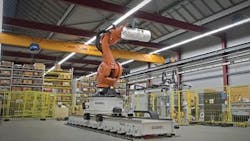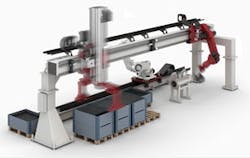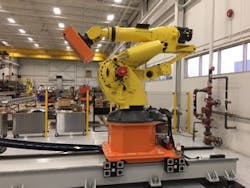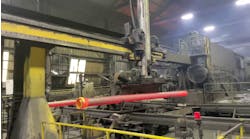Rochelle received his bachelor’s and master’s degree in engineering from Virginia Tech; his industrial-automation career spans more than 30 years, in which he’s held positions in engineering, sales, general management and consulting. Rochelle is a veteran speaker for industry groups, has taught engineering at the university and community-college level, and he led a committee writing the first sanitation standard for industrial robots in the food processing industry. Rochelle is a past member of the Robotic Industries Association (RIA, www.robotics.org) board of directors. Contact him at [email protected].
When you decide to look at automation to increase efficiency, increase production rates, improve consistency and reduce the number of non-value-added tasks that your labor performs, it would be wise to consider robot-based automation. Robots have limitations but where applicable they can pay rich dividends when properly deployed. Robotics industry professionals will be happy to guide you in this process and will not make the mistake of trying to apply this technology where it does not fit.
So, how do you get started with robotics? First, have a robot industry veteran evaluate your processes and look for tasks that are dangerous to the human performing them, boring or repetitive tasks, heavy tasks that require excessive exertion or lifting that requires more than one person to perform, high-speed manual moves and tasks that do not require human thought to make a decision (Figure 1).
Applications exist in your processes. Some can be performed with a standard robot-based automation system, and others may require the design of a system with some level of customization (Figure 2). For example, if the process identified is welding, there are a number of commercially available robot welding systems that are mature designs and may fit your application perfectly. Using one of these standard systems avoids the cost of custom design. And by custom we do not mean 100% ground-up design. Most often automation systems are created by combining readily available peripheral equipment, and the customization is only to fit it to your production process and plant requirements.
Figure 1: Look for tasks that are dangerous to the human performing them, boring or repetitive tasks, heavy tasks that require excessive exertion or lifting that requires more than one person to perform, high-speed manual moves and tasks that do not require human thought to make a decision.
Select a simple process or one that has a history of successful robot installations to start with from those identified. For example, palletizing is a simpler system than one requiring multiple camera inputs to inspect shape and detect color to perform a sorting operation. The plan for the first installation is to have an immediate success to ensure your entire organization learns, understands and accepts this new technology.
Find processes to automate in your plant and identify a preliminary technical solution whose costs can be estimated (Figure 3). After agreeing that the system meets your budget and any ROI criteria, begin the process of system development.
Figure 2: Some applications may require the design of a system with some level of customization.
First, decide if you will build the system yourself or you’ll employ a system integrator to provide the automation system. If you are getting started, then it is reasonable to assume that you will want to engage the services of an integrator. So, how do you select the right system integrator for your company culture and system needs? Taking a few steps to properly vet them means determining if the integrator has experience in your industry or application, evaluating the integrator’s background and capabilities, checking references, assuring the integrator has the technical expertise and staff to both provide the system and support it in the future and have the financial ability to procure the amount of materials needed for your system. You need to be comfortable that the integrator chosen fully understands your process, can supply a comprehensive solution to your automation needs and can support it far into the future.
Solicit more than one integrator to propose a solution because each one’s system concepts may be vastly different, and one may be highly advantageous over the others. Verify that the system design accounts for any currently known or potential production expansions. Check on the system’s ability to introduce new parts or new processes to it and remember before making the decision that the lowest-priced system is cheap for a reason.
ALSO READ: The keys to robot selection, safety and collaboration
Figure 3: Find processes to automate in your plant and identify a preliminary technical solution whose costs can be estimated.
The process that you will follow with your chosen integrator varies if the system is one of the standard systems you can select from a portfolio of sizes, speeds or other ratings versus a system that has some quantity of custom design. Regardless, your current manual process plus the upstream and downstream processes will be evaluated to ensure suitability of adding an automated system. Other items that will be questioned are the level of operator involvement with the automation; part or process quality-control issues that are in place in this process; interface with your production system in terms of part movement and data collection requirements; and your company’s technical ability to take ownership of the system to operate and maintain it successfully after installation.
Next in the process, some preliminary layouts and designs will need to be created to determine space required, parts movement, tooling and fixture needs, safety concerns, design of any interfaces to your production system and operator communications. This process may include simulations of the system, cycle time studies and any verification tests to prove that the automation system concept is correct and will work. After the system design is approved, the system is built, which includes procurement of peripheral equipment, fabrication of components where required, system building, programming, testing and debugging.
The installation site needs to be cleared of any equipment and then prepped with utility services and any other structural needs for the new system. Consideration for your current parts production needs must be made to keep customers satisfied during the installation period. Will you continue, suspend or work around the install, startup and implementation of your new system? After successful installation, startup and personnel training, the new system is fully commissioned. A final review of the system and development process will be held to suggest any improvements to the project.
Typically, within a short period of time after successful implementation of an automation system, you will identify other areas where this technology is the right fit. You should be considering robotics technology because your competitors are.









